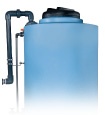Selecting the right chemical storage solution can feel overwhelming, especially when safety, compliance, cost-effectiveness, and useful life are all on the line. Whether you're upgrading your existing tank infrastructure or implementing a new storage system, understanding your options will help you make an informed decision that protects both your operation and your bottom line.
Topics:
Tank Design and Materials
Proper tank design is crucial to successful and safe chemical storage. Purchasing a chemical storage tank isn't just about selecting the right size — it is vital to design the proper tank configuration for the safety of your employees, the protection of the environment, and to get the most out of your investment.
Topics:
Tank Design and Materials
Building in flood-prone areas requires careful consideration of both safety standards and insurance implications. These considerations apply not only to homes and building structures, but even to chemical storage systems.
Topics:
Tank Design and Materials
Purchasing a high-performance chemical storage tank is a significant investment for your company, and choosing the right tank for your needs isn't always an obvious decision. Whether you're considering fiberglass reinforced plastic (FRP), stainless steel, mild steel, or crosslinked polyethylene (XLPE) tanks, it's essential to understand the differences between them and to know what to expect in terms of cost, maintenance, service, delivery times, and protection.
Topics:
Tank Design and Materials
When installing a plastic storage tank, whether for water, chemicals, or other liquids, the foundation pad might seem like a simple concrete slab. However, proper pad design is critical for tank performance, longevity, and safety – and it's more complex than you might think.
Topics:
Tank Design and Materials
When it comes to chemical storage solutions, proper planning can make all the difference between a smooth project timeline and costly delays. Understanding lead times for different tank materials and manufacturers is crucial for project managers, engineers, and facility operators who need reliable chemical storage systems.
Topics:
Tank Design and Materials
Poly Processing’s SAFE-Tank® double wall tank system is a revolutionary “tank-within-a-tank” design that provides secondary containment to avoid damaging equipment or property, loss of chemicals, or injury to employees in the event of a spill. Our newest 10,500 gallon capacity expands your options for safe, reliable chemical storage.
Topics:
Tank Design and Materials
On January 9,2014, a chemical spill fouled the water supply for thousands of West Virginians. "Crude MCHM," 4-methylcyclohexane methanol used in washing coal and removing impurities, leaked from a facility into the Elk River near Charleston, WV. In addition to the leak at the chemical storage facility, the organization has since been cited for unsafe storage conditions at a second chemical storage site. The company had subsequently filed for bankruptcy.
Topics:
Tank Design and Materials
The chemical storage tank industry presents unique workplace challenges, as workers frequently access elevated equipment and fittings on the domes of storage tanks. According to the World Health Organization, falls rank as the second leading cause of unintentional injury death worldwide. For chemical storage facilities, implementing robust fall prevention measures is absolutely critical.
Topics:
Tank Design and Materials
When operating chemical storage facilities, there might come a time when you need to repurpose a tank to store a different chemical. This transition requires careful planning and should not be done without performing due diligence. Any time you repurpose a chemical tank for a different stored chemical, it requires critical considerations for safety, chemical compatibility, and regulatory compliance. In almost all cases, we recommend purchasing a new tank for the chemical you want to store, because every tank is engineered specifically for the particular chemical you originally intend to store. Under certain scenarios, it may be possible to repurpose a chemical storage tank. Here's an introductory overview of a few critical considerations that would need to be addressed when evaluating tank repurposing.
Topics:
Tank Design and Materials



